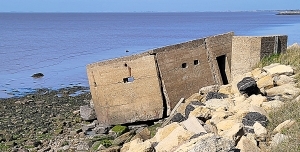Adam Yamey's Blog: YAMEY, page 18
April 14, 2025
Washing the dishes as a kind of therapy
SEEING A PILE of unwashed pots and other cooking utensils reminded me of my father, who died aged 101 in 2020. A couple of years ago, I began writing my memories of him as a father, but have never completed the work. However, here is an excerpt that relates to my father and the kitchen sink:
“Many people who knew my father would not have associated him with household chores. And that would be largely correct. My mother was more involved than Dad with the practical running of the household. However, there were a few things that he did on a regular basis. One of these was washing the dishes after a meal.

Dad had a rather puritanical attitude to work. Often, I felt that he considered it to be unworthy to stop working to relax, yet he did, but sometimes in an unusual way. He liked standing at the kitchen sink doing the washing of dishes, cutlery, and cooking utensils. By doing this, he was relaxing by being away from his desk, but he was not wasting time by doing nothing. He felt that he was achieving something useful whilst at the same time he was relaxing or just thinking about his academic work. When we bought our first dishwashing machine in the 1960s, I felt that Dad regretted it, because this machine had reduced the amount of time he could pass standing at the kitchen sink. Because my mother refused to put pots and pans and cooking knives in our machine, he was not entirely deprived of his time at the sink.“
Having shared this with you, I will now head for our kitchen sink, and tackle the task that confronts me.
April 13, 2025
Bunker on the shore
April 12, 2025
A man from Guyana and Mahatma Gandhi in Hull
THERE IS A GARDEN close to the Wilberforce House Museum and other museums in the old part of Hull (Yorkshire). At one side of this well-tended space, the Mandela Gardens, with his back to the Wilberforce House, there is a bust of the Indian freedom fighter Mahatma Gandhi (1869-1948). The bust was created by an artist from Maharashtra, Jaiprakash Shirgaonkar (born about 1952). When I saw it, I wondered whether Gandhi had ever visited Hull. I do not think he did. On the back of the plinth that supports the bust, there is an inscribed plaque, facing Wilberforce House, with some words spoken (or written) in May 1983 by Sir Sridath (‘Sonny’) Ramphal (1928-2024), who was born in what was British Guiana. They read:
“I invite each and every one of you, citizens of Hull and other friends, to question whether any can take pride in the work and achievements of Wilberforce and the Anti-slavery Movement if, as a nation, as a world community, we fail to take a righteous and uncompromising stand against apartheid. By what quirk of logic, what twist of values can we celebrate emancipation and tolerate apartheid? …”
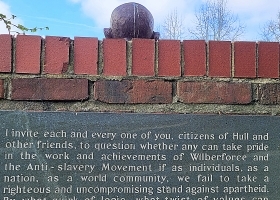
These words were spoken (or written) in 1983, and apartheid ended in South Africa only in 1994.
The bust of Gandhi was unveiled in October 2018. The following year, Gandhi’s grandson Gopal Gandhi (a former IAS officer and diplomat who was the 23rd Governor of West Bengal, serving from 2004 to 2009) visited Hull to celebrate what would have been the Mahatma’s one hundred and fiftieth birthday. In anticipation of his visit, one of Hull’s then councillors Dave Craker said:
“Hull has a long history of being a city that, like Gandhi, promotes and fights for freedom and civil liberties, so it’s fantastic that we are able to welcome his grandson, Gopal Gandhi, this summer to celebrate his grandfather’s 150th birthday.” (https://news.hull.gov.uk/24/05/2019/gandhis-grandson-coming-to-hull-for-grandfathers-150th-birthday/).
So, even if the Mahatma never visited Hull, at least one member of his close family managed to get there.
Returning to Ramphal, whose words are at the back of Gandhi’s monument, he did have a significant connection with Hull, and visited the city. In 1983, this former Commonwealth Secretary General (from 1975 to 1990) gave a lecture at the University of Hull, which had awarded him an honorary degree.
April 11, 2025
Knife Edge outside the Houses of Parliament
THERE ARE MANY sculptures by Henry Moore (1898-1986) in London’s public spaces (see: https://londonist.com/london/art-and-photography/where-to-find-henry-moore-sculptures-in-london). One of them, “Knife Edge Two Piece”, can be seen on College Green, opposite the Houses of Parliament. Consisting of two huge pieces of bronze, this was created by Moore between 1962 and 1965. Its form was inspired by a fragment of animal bone, as are many of his other sculptures. When we visited Moore’s home in Perry Green (Hertfordshire), we saw display cases filled with bits of bone the artist had collected over the years,
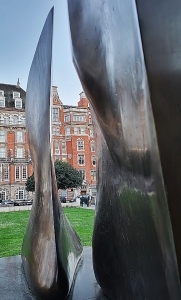
The sculpture outside the Houses of Parliament is one of three casts of the same work. The other two are in Canada and the USA. Moore donated the sculpture that stands in Westminster, to the Nation in 1967. In 2011, it became part of the Parliamentary Art Collection. It is now a listed object. It is one of only 41 post-WW2 sculptures in Britain to have been awarded the listed status.
Henry Moore is one of the greatest of British twentieth century artists. It is fitting that his sculpture should stand amidst buildings that have played, and continue to play, important roles in the life of the country.
April 10, 2025
A Roman mosaic
April 9, 2025
Misled by a label at an exhibition in Hull
THE FERENS ART Gallery in the centre of Hull contains a superb collection of well-displayed artworks dating from the fourteenth century until today. While we were visiting it, we viewed a temporary exhibition of works that depict sirens, the mythological females that lure sailors to their deaths. One of the exhibits, on loan from the British Museum, is a fifth century BC Greek vase, which bears one of the earliest known depictions of the Sirens and Ulysses. Magnificent as this is, another exhibit also intrigued me.

It is a painting by Annie Swynnerton (1844-1933), called “Oceanid” and created in 1904. Next to the painting, the museum has installed an information panel that includes the following:
“The first woman to join the Royal Academy since it was founded in 1768, Swynnerton forced open the door of the artworld for many to follow.”
Well, that surprised me because I knew that the female painter Angelica Kauffman (1747-1807) had been involved with London’s Royal Academy of Arts (‘RA’). She and another woman, the artist Mary Moser (1744-1809) were founding Members of the RA. However, despite these two women, the RA remained a strictly male preserve for a long time. So, how could the Ferens Gallery have justified what was written on the label next to Swynnerton’s painting? The explanation can be found on a page of the RA’s website (www.royalacademy.org.uk/article/magazine-ra250-female-invasion-women-at-the-ra):
“Finally, in 1922, the painter Annie Swynnerton became the first woman Associate of the RA (now a defunct category of membership). This historic breakthrough meant little in practice; Swynnerton was 78 years old by this point and never became a full RA. She was followed by Laura Knight who was elected as an Academician in 1936. Knight acknowledged the importance of her predecessor saying, ‘Any woman reaching the heights in the fine arts had been almost unknown until Mrs Swynnerton came and broke down the barriers of prejudice’.”
Although at first sight, the exhibition label seemed to suggest that before Swynnerton, the RA had been closed to women, it is not completely inaccurate, but I felt that its wording could easily be misleading.
April 8, 2025
Wonderful Roman mosaics preserved near the Humber river
KINGSTON UPON HULL (‘Hull’) did not exist as a significant settlement until several centuries after the Romans left Britain. However, the Romans built a road that ran north through Brough, which is west of Hull, to Malton (northwest of Hull), and beyond towards York. Along this road, at Horkstow and Brantingham, and at Rudston and Harpham, along a side road northeast of Hull, remains of buildings constructed by the Romans have been found and excavated by archaeologists. At each of these sites, large areas of Roman mosaics have been found.
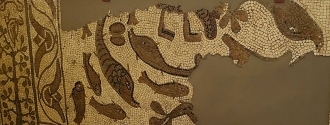
The mosaics have been carefully moved to Hull and can be seen at the city’s Hull and East Riding Museum. There, they have been beautifully displayed. I do not think I have ever seen such a large collection of Roman mosaics as can be found in the museum. It is worth visiting Hull to view this remarkable set of mosaics. Although, in my view, the mosaics alone make the museum unmissable, there is much more to be seen in this superbly curated place.
Visitors to the museum, which specialises in archaeology, follow a route that leads from exhibits relating to prehistory to just after the English Civil War. Each room or area along the way is designed to ignite interest in archaeology in the minds of everyone, from small children to adults. Every exhibit is labelled in language that is easy to understand, yet does not ‘dumb down’. Even if you enter the museum with little interest in archaeology and early history, you are bound to leave having become interested in these subjects.
Apart from the Roman mosaics, the museum contains several timber boats, the Ferriby vessels, that were built on the bank of the Humber in the Bronze Age. One of these is preserved in a special tank called the Boatlab, which contains equipment to preserve the ancient timber. It is believed the Ferriby boats are the earliest known form of seacraft made in Europe.
I have highlighted two aspects of this museum in Hull. They are the ‘icing on the cake’, but the rest of the cake is richly interesting. Many people disdain the idea of visiting Hull, but they are mistaken. The museum with its Roman mosaics is just one of many of the city’s relatively unknown but worthwhile attractions.
April 7, 2025
A wise choice of a pub in Hull
ESTABLISHED IN 1829, the Minerva is a pub next to the Humber River and close to the recently developed Hull Marina. It has a genial atmosphere, friendly staff, good unpretentious food, and a fine range of alcoholic beverages.
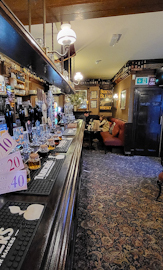
The place consists of several interconnecting rooms where one can eat and drink. One of these rooms is tiny. It can accommodate 4 adults at a squeeze and is, apparently, the smallest pub room in England.
We ate at the Minerva 4 evenings in a row, and were never disappointed. The fish and chips served at this pub were second to none. If you happen to be in Hull, it would be wise to visit the sign of the owl at the Minerva pub to have a good time.
April 6, 2025
Pierced by a bullet while praying in the pews
BEVERLEY IN YORKSHIRE is best known for its cathedral-like Minster. Our friend Colin recommended that while in Beverley, we should not miss visiting the church of St Mary. We went there and enjoyed exploring this magnificent medieval gothic parish church. We were shown around by a volunteer who pointed out something we had never seen in any other church.
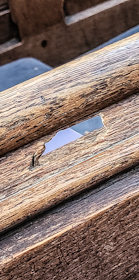 The bullet hole
The bullet holeIn WW2, during an air attack on Beverley, a German aeroplane strafed the town. One of the bullets from the ‘plane made a hole in a stained glass window on the south side of the church, and went straight through one of the worshippers, killing him. The volunteer showed us the hole in the wooden pew made by the bullet after it had passed through the unfortunate parishioner. The wooden pew behind the one with a hole has a hollowed out spot caused by the bullet after it had penetrated the pew in which the victim had been seated.
Years later, the volunteer related, a woman from Australia visited St Mary’s, and when she saw the damage caused by the bullet, she burst into tears. The man who had been killed while praying had been her grandfather.
April 5, 2025
An accountant crossing a river without a bridge or a boat
THE HUMBER BRIDGE was constructed between 1973 and 1981. Sometime during that period, my wife was a trainee accountant. One of the assignments that she was sent on was to audit the Humber Bridge construction. She arrived at the site after the completion of the two towers from which the bridge was to be suspended, but long before the span traversing the water had begun to be built. The two towers were then only connected by a cable ropeway.

Being a conscientious auditor and of an adventurous frame of mind, she wanted to investigate the situation close-up. She managed to persuade site manager that to do her job properly, she needed to cross the water via the cradle that the workers used, which was suspended from the ropeway. Having done this, she included it in her audit. When her senior read the report, he looked at my wife and rolled his eyes incredulously.

